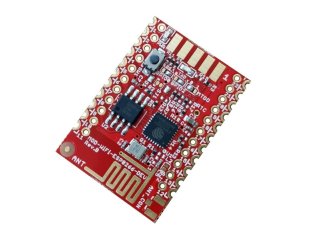MOD-WIFI-ESP8266-DEV



| Price | 3.45 EUR |
|---|---|
| 10 - 49 pcs | 3.28 EUR |
| 50 - 10000 pcs | 3.11 EUR |
MOD-WIFI-ESP8266-DEV is OSHW certified Open Source Hardware with UID BG000014
MOD-WIFI-ESP8266-DEV is recommended for people that already have some experience with ESP8266. Consider ESP8266-EVB if you are a complete beginner.
FEATURES
- Main chip: EPS8266EX
- 2MB (16Mb) SPI flash memory
- Power LED
- User-programmable LED
- Button for UART mode (since hardware revision B)
- SMT jumpers for different boot modes (FLASH, UART, SDO)
- PCB antenna
- UEXT pads for easier access to UART interface
- Pads for a U.FL antenna connector (if you want to use external antenna)
- 22 pin holes @ 0.1" step for easier access to processor pins
- OSHW desgn
- Dimensions: (1.3 x 0.9)" ~ (3.3 x 2.3)cm
DOCUMENTS
- Boot modes reference (FLASH, UART, SDIO)
- ESP8266EX datasheet
- How to update firmware
- More ESP8266EX-related documents are available here: official espressif web-site and here: official espressif forum
- MOD-WIFI-ESP8266-DEV European Declaration of Conformity
- MOD-WIFI-ESP8266-DEV UKCA Declaration of Conformity
HARDWARE
SOFTWARE
FAQ
-
How do I put the board in UART mode (so I can change the firmware or upload program via Arduino IDE)?
-
Press and hold the button and then apply power supply; release the button. Alternatively, set the jumpers to UART mode and after the upload is done, revert them back to the original FLASH mode.
-
How do I send AT commands to the board?
-
You need to establish UART connection to the board (using RX, TX, GND). The best approach is to use a USB to serial cable with 3.3V voltage levels and 3.3V power supply. The board's jumpers have to be set to the default FLASH mode. Remember to connect both ground lines - that of the serial cable and the one of the power supply the respective GND pads of the board (a single GND connection would be required if your serial cable is also capable of powering the MOD-WIFI-ESP8266-DEV).
-
I want to send basic AT commands to the board but I receive no response. The strange thing is that I receive "ready" when I power the module. What is the problem?
-
All AT commands must end with carriage return and line feed - "/r/n". Your terminal software might have such a new line option - transmiting CR+LF at the end of each command. If it doesn't - either use another terminal software or try to send the commands with "CTRL"+"J" keyboard combination, instead of "ENTER".
-
I send basic AT commands to the board but I receive only "ERROR" response. What is the problem?
-
The commands are case sensitive. Make sure you are using capital letters.
-
Newly purchased boards can't be programmed via Arduino IDE. What is the difference compared to previous revisions?
-
The SPI memory had to be changed due to unvailability of the original one. New memory requires different flash mode, make sure to select QOUT instead of QIO (as it was before). Refer to the latest schematic.







